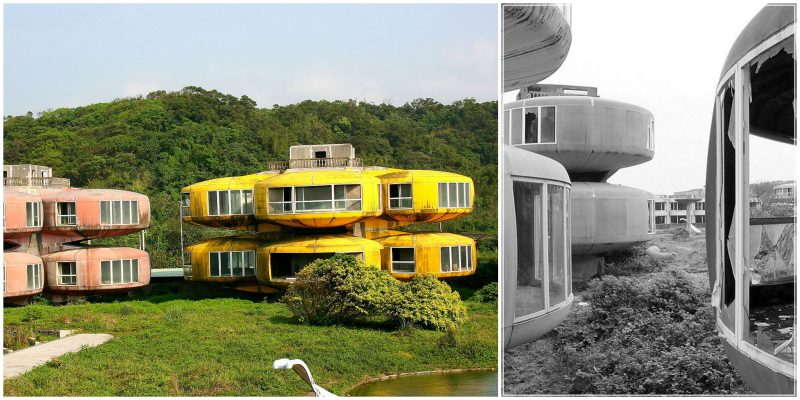The Sanzhi UFO houses also known as the Sanzhi pod houses or Sanzhi Pod City, were a set of abandoned pod-shaped buildings in Sanzhi District,New Taipei City, Taiwan. The buildings resembled Futuro houses, some examples of which can be found elsewhere in Taiwan.The site where the buildings were located was owned by Hung Kuo Group.
The now demolished complex that once was an innovative project of futuristic homes, is made up of the eccentric UFO inspired style called Futuro.



The UFO houses were constructed beginning in 1978. They were intended as a vacation resort in a part of the northern coast adjacent to Tamsui, and were marketed towards U.S. military officers coming from their East Asian postings.However, the project was abandoned in 1980 due to investment losses and several car accident deaths and suicides during construction, which is said to have been caused by the unfortuitous act of bisecting the Chinese dragon sculpture located near the resort gates for widening the road to the buildings.Other stories indicated that the site was the former burial ground for Dutch soldiers.The pod-like buildings became a minor tourist attraction due in part to their unusual architecture. The structures have since been subject of a film, used as a location by MTV for cinematography, photographed by people, and become a subject in online discussions, described as a ghost town or “ruins of the future”.The houses are referred to in the title of a track on the experimental Germanpianist Hauschka’s 2014 LP Abandoned City.






The buildings were scheduled to be torn down in late 2008, despite an online petition to retain one of the structures as a museum. Demolition work on the site began on 29 December 2008, with plans to redevelop the site into a tourist attraction with hotels and beach facilities.
By 2010, all of the UFO houses had been demolished and the site was in the process of being converted to a commercial seaside resort and water-park.
The Futuro house was a product of post-war Finland, reflecting the period’s faith in technology, the conquering of space, unprecedented economic growth, and an increase in leisure time. It was designed by Suuronen as a ski cabin that would be “quick to heat and easy to construct in rough terrain.” The end result was a universally transportable home that had the ability to be mass replicated and situated in almost any environment.By the mid 1970s, the house was taken off the market. From the beginning, it had been met with public hostility. The first Futuro that was erected near Lake Puulavesi in Finland elicited public protest because it looked too unnatural for the rustic environment. In the United States Futuro houses were banned from many municipalities by zoning regulations. Banks were reluctant to finance them. Some were vandalized. Some customers who committed to buy them backed out and forfeited their non-refundable $1000 deposits. Some have been destroyed. In 1999, the City of Tampa ordered a Futuro demolished.
